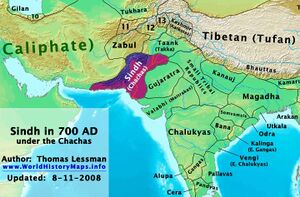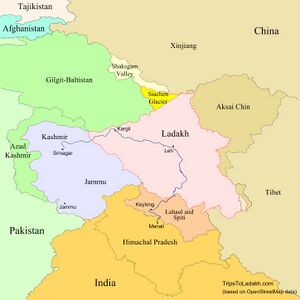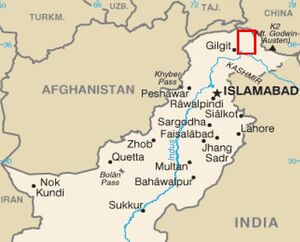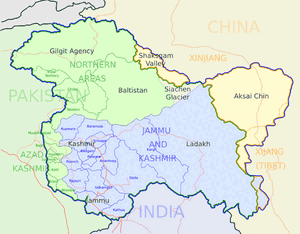Gilgit
| Author:Laxman Burdak, IFS (Retd.) |
Gilgit (Hindi:गिलगिट, Urdu, Shina: گلگت) is the Capital city of Gilgit-Baltistan, an administrative territory claimed by Pakistan disputed with India. The ancient country of Daradas, (Dardistan) is identified to be the Gilgit region in Kashmir along the river Sindhu or Indus. Tushara Janapada mentioned in Mahabharata is now in Gilgit.
Bolor was one of Buddhist places visited by Xuanzang in 631 AD. Bolor has been identified with the modern Balti, or Little Tibet by Alexander Cunningham.[1]
Contents
Origin
Gilgit gets name from Gill Jat clan.
Variants of name
- Gilgit (Hindi:गिलगिट)
- Geelt (Burushaski language)
- Ghallata (ancient Sanskrit literature)
- Gilit (local people)
- Gilligitta (city of Gill Jats)
- Gilt (Wakhi and Khowar lang)
- Palola
- Sargin
- Sargin-Gilit (local people)
- Sargin Gilit (by H. W. Bellew)
Jat clans
Gilgit District
The city of Gilgit constitutes a tehsil within Gilgit District. Gilgit District is bounded by the Wakhan Corridor (Afghanistan) to the north; Xinjiang (China) to the northeast and east; Skardu, Astore and Diamer to the south; and Ghizer District to the west.
The district includes Gilgit town, Bagrot Valley, Juglot, Danyore, Naltar, and Nomal.
Geography of Gilgit District: Only a part of the basin of the Gilgit River,i.e. Gilgit Valley is included within the political boundaries of Gilgit District.
Rivers: The main rivers in the District are:
- Khunjerab River - flows south along the Karakoram Highway from the Khunjerab Valley, known as Hunza River in the south of Sust.
- Hunza River - flows further south and falls into Gilgit River just in the northeast of Gilgit town
- Gilgit River - enters Gilgit District from west in the south of Bichhar Pass (Naltar Valley) and flows west through the Gilgit town. It is one of the Rivers in Rigveda named Trstama (त्रिश्टामा) (X.75.6.) which is identified with Gilgit?
- Indus River - enters Gilgit District from Skardu District about six kilometers north of Jaglot where Gilgit River falls into Indus River and the Indus flows south along the Karakoram Highway.
There are many tributaries of the above main rivers, some of which are Ghujerab River, Shimshal River, Hispar River, Naltar River and Yaheen River.
Passes: Khunjerab Pass, Mintika Pass, Kilik Pass, Chillingi Pass, Shimshal Pass, Ghujerab Pass, Chapchingal Pass, Chaprot Pass, Naltar Pass and Talmutz Pass.
Lakes: Naltar Lake, Borit Lake, Rush Lake (Rush Peak), Pahote Lake, Nomal, Gilgit Baltistan
History

The city's ancient name was Sargin, later to be known as Gilit, and it is still referred to as Gilit or Sargin-Gilit by local people.[2]
In the Burushaski language, it is named Geelt and in Wakhi and Khowar it is called Gilt. Ghallata is considered its name in ancient Sanskrit literature.
Gilgit was an important city on the Silk Road, along which Buddhism was spread from South Asia to the rest of Asia. It is considered as a Buddhism corridor from which many Chinese monks came to Kashmir to learn and preach Buddhism.[3]
The Dards and Shinas appear in many of the old Pauranic lists of peoples who lived in the region, with the former also mentioned in Ptolemy's accounts of the region. Two famous travellers, Faxian and Xuanzang, traversed Gilgit according to their accounts.
H. W. Bellew[4] writes that Sargin is the name of the Gilgit valley, and may stand for a Darda tribe from that place.
H. W. Bellew[5] thinks that The Shin of Gilgit and Dardistan represent the China named by Manu amongst the races of the Kshatriya class, or Rajput, who by their neglect of Brahmanism, gradually sunk to the Sudra class, the lowest of the four classes of Hindus. The China who thus lapsed from the Kshatriya to the Sudra class are named by Manu along with the Parada, Pahlava, Kirata, Darada, and Khasa ; all which races inhabited the mountainous country between Kabul and Kashmir in which Buddhism long held its strongest sway.
Gilgit-Baltistan
Gilgit-Baltistan (Urdu: گلگت بلتستان), formerly known as the Northern Areas,[6] is the northernmost administrative territory of Pakistan.[7] It borders Azad Kashmir to the south, the province of Khyber Pakhtunkhwa to the west, the Wakhan Corridor of Afghanistan to the north, Xinjiang, China, to the east and northeast and Jammu and Kashmir to the southeast. The region, together with Azad Kashmir, Aksai Chin, Shakshagam Valley of China and Jammu and Kashmir, is disputed between India, China and Pakistan.[8][9]
The territory of present-day Gilgit-Baltistan became a separate administrative unit in 1970 under the name "Northern Areas". It was formed by the amalgamation of the former Gilgit Agency, the Baltistan district and several small former princely states, the larger of which being Hunza-Nagar.[10] In 2009, it was granted limited autonomy and renamed to Gilgit-Baltistan via the Self-Governance Order signed by Pakistan president Asif Ali Zardari, which also aimed to empower the people of Gilgit Baltistan.
H. W. Bellew[11] writes that ....In the north-east of Bactria, the country which appears on our maps as Bolor, but in native books is written Balur, was probably included in Bactria, and comprised the districts of Chitral or Kashkar, Yasin, Gilgit, and Skardo. In fact, it appears that the word Balur itself is merely a natural variant form of Bakhtar.
Bolor was one of Buddhist places visited by Xuanzang in 631 AD. Bolor has been identified with the modern Balti, or Little Tibet by Alexander Cunningham.[12]
Alexander Cunningham[13] writes about 8. Bolor or Balti: From Darel Hwen Thsang travelled 500 li, or 83 miles, over a mountain range, and up the valley of the Indus to Po-lu-lo, or Bolor. This district was 4000 li, or 666 miles, in circuit; its greatest length being from east to west. It was surrounded by snowy mountains, and produced a large quantity of gold. This account of the route, compared with the bearing
[p.84]: and distance, show that Po-lu-lo must be the modern Balti, or Little Tibet, which is undoubtedly correct, as the people of the neighbouring Dardu districts on the Indus know Balti only by the name of 'Palolo[14] Balti also is still famous for its gold washings. The name, too, is an old one, as Ptolemy calls the people Bύλταί, or Byltae. Lastly, both in size and position Balti corresponds exactly with the account of the Chinese pilgrim, as the length of the province is along the course of the Indus from east to west for 150 miles, and the breadth about 80 miles from the mountains of Deoseh to the Karakoram range, or altogether 460 miles in circuit, as measured direct on the map, or about 600 miles by road measurement.
History of Gilgit-Baltistan
Between 399 and 414, the Chinese Buddhist pilgrim Faxian visited Gilgit-Baltistan,[15] while in the 6th century Somana Palola (greater Gilgit-Chilas) was ruled by an unknown king.
Between 627 and 645: The Chinese Buddhist pilgrim Xuanzang travelled through this region.
From 644 to 655, 671: Patoladeva alias Navasurendrādityanandi was King of Palola (Gilgit ).
Patoladeva alias Vajraditya Nandin of Gilgit (6-7th c.)
In 706/707, Jayamaṅgalavikramādityanandi became the King of Palola.
It is said that in the year 717, a delegation of a ruler of great Palola, named Su-fu-she-li-ji-li-ni according to the transcription of Chinese characters, reached the Chinese imperial court.
In 719, Su-fu-she-li-ji-li-ni, King of Palola, sent a second delegation to the Chinese Imperial court.[16]
At least in 719/720 Ladakh (Mard) was part of the Tibetan Empire.
About 720 Buddhism is practiced in Baltistan and Sanskrit was the written language. It is unknown if Baltistan temporarily belonged at that time to Palolo.
720: Delegation of Sou-lin-t'o i che (= Srideva alias Surendrāditya), King of Palola, to the Chinese imperial court. The Emperor gives the ruler of Cashmere "Tchen-fo-lo-pi-li (Chandrāpīḍa)" the title of "King of Cashmere". At least 721/722: Baltistan is part of the Tibetan Empire.[17]
721/722: The conquest of Little Palola or Bru-zha (Yasin) by the Tibetan army fails. Mo-ching-mang (Mo-kin-mang) is King of Palola.
With 723 727/28: The Korean Buddhist pilgrim Hyecho (Huichao) reached Palola.
In 737 / 738 Tibetan troops under the leadership of Minister sKyes-bzang ldong-tsab conquer Little Palola.
740/41: The Tibetan Princess Khri-ma-lod was sent as a bride of Su-shih-li-chi, the ruler (rje) of Little Palola.
747: Reconquest of Palola by a Chinese army under the leadership of the ethnic-Korean commander Gao Xianzhi (Kao Hsien-chih).[18]
753: Conquest of Great Palola by a Chinese army under the military Governor Feng Changqing until 755 due to the An Lushan rebellion the Chinese lost its supremacy in Central Asia and in the regions around Gilgit Baltistan.[19]
Turks arrived in Gilgit during the 7th century, they practiced zoroastrianism and were founders of Trakhan dynasty in Gilgit.
During 8th century, Tibetans were known to live in Baltistan. Rulers of Gilgit formed an alliance with Chinese T'ang Dynasty and forced Arabs back with their help.[20]
Gilgit-Baltistan was ruled by many local rulers amongst them Maopons of Skardu and Rajas of Hunza were famous. The Maqpons of Skardu unified Gilgit Baltistan with chitral, ladakh specially in the era of Ali Sher Khan Anchan[21] who had a friendly relation with Mughal court.[22] Anchan reign brought prosperity in art, sport,and variety in architecture He introduce polo in gilgit region and in chitral he sent group of musician in Delhi to learn Indian music and due relation with Mughals The Mughal architecture influenced Architecture of the region as well.[23]
After Anchan in his successors Abdal Khan had great influence though In the popular literature of Baltistan he is still alive as dark figure by the nickname "Mizos" "man-eater". The last raja of Maqpons was Ahmed Shah who ruled 1811-1840 in entire baltistan. The areas of Gilgit, Chitral, and Hunza get independence of Maqpons many year before.
Before the demise of Shribadat, a group of Shin people migrated from Gilgit Dardistan and settled in the Dras and Kharmang areas. The descendants of those Dardic people can be still found today, and is believed that they have maintained their Dardic culture and Shina language up to the present time.
Daradas were a people who lived north and north-east to the Kashmir valley. This kingdom is identified to be the Gilgit region in Kashmir along the river Sindhu or Indus. They are often spoken along with the Kambojas. The Pandava hero Arjuna had visited this country of Daradas during his northern military campaign to collect tribute for Yudhisthira's Rajasuya sacrifice. Daradas are at present found in form of Daral Jats.
Sir H. M. Elliot, Edited by John Dowson[24] writes ...Then there are the mountains of Bíllúr, in the direction of Turkistán, which are denominated Shamílán.In two days' journey you arrive at Turkistán, where the Bhutáwariyas dwell. Their king is called Bhut Sháh, and their countries (bilád) are Gilgit, Asúra, Salsás, etc., and their language is Turkí. The inhabitants of Kashmír suffer greatly from their encroachments and depredations.
Sir H. M. Elliot Edited by John Dowson[25] mentions The Hindu kings of Kabul ....The Katormans, or Kators, have hitherto been better known to modern than ancient history. We are informed that it was the name of one of the tribes of Kafiristan, and that the ruler of Chitral to this day bears the title of Shah Kator, and I have heard the same designation given to the chief of Gilgit. The country of Kator is also spoken of by Sadik Isfahani, as being the country of the Siyahposhes, or black-vested, on the borders of Kabul. These Kators boast still of their Grecian lineage, and their claim to this honour is by no means, as many have supposed, of modern origin, attributable to our own enquiries after the descendants of the followers of the Macedonian conqueror.
Districts of Gilgit–Baltistan
There are ten districts in Gilgit–Baltistan, four in Baltistan division and six in Gilgit division(including Diamer region). The number rose from 7 to ten after addition of 2 districts in baltistan and separation of Hunza-Nagar district.
| Sr. No. | District | Capital | Area (km²) | Population (1998) |
|---|---|---|---|---|
| Baltistan | ||||
| 1 | Ghanche | Khaplu | 6,400 | 88,366 |
| 2 | Skardu | Skardu | 15,000 | 214,848 |
| 3 | Shigar | Shigar | 8,500 | 109,000 |
| 4 | Kharmang | Tolti | 5,500 | 20,000 households |
| Gilgit | ||||
| 5 | Astore | Eidgah | 8,657 | 71,666 |
| 6 | Diamer | Chilas | 10,936 | 131,925 |
| 7 | Ghizer | Gakuch | 9,635 | 120,218 |
| 8 | Gilgit | Gilgit | 38,000 | 243,324 |
| 9 | Hunza | Ali Abad | 7,900 | |
| 10 | Nagar | Gulmet | 5,000 | |
Jat History
Daral (दराल)[26][27] Darel Drall (दराल) Darad (दरद)[28] Daraad (दराड़)[29] is the surname/Gotra of Jats living in the outskirts of Delhi and Haryana. They are said to have descended from ancient people called Dard (दर्द), a term applied by the Mair to the tribes of the Indus Kohistan who live on the left bank of that river : Biddulph's Tribes of the Hindoo Koosh, p. 12.[30]
Gilt (गिल्ट) is a gotra of the Jats.[31][32]
Ram Sarup Joon[33] writes that upto the time of Maharaja Ranjit Singh (Punjab) Gilgit was the capital of Gills which was conquered by Ranjit Singh.
Tushar (तुषार) Tukhar (तुखार) Tusiar (तुसियर) Tusir (तुसीर) Tushir (तुशीर) gotra of Jats originated from Tushara (तुषार) janapada mentioned in Mahabharata. This place is now in Gilgit. There was Tusharagiri mountain also. [34]
Bhim Singh Dahiya[35] that We find the form 'Git' nearer home again, in the name of the city of Kashmir, viz., Gill git. Its old form is 'Gilligitta”. i.e. the Gill Jats. Buddha Prakash mentions a Sanskrit inscription of seventh century A.D. of king Potal Deva Sahi, whose minister Makara Simha is called a Saramgha of Gilligitta. 5Here Potal as well as Saramgha, are names of Jat clans called Potalya and Saranha, respectively.
Bhim Singh Dahiya[36] writes that this form of their name Guti appears in India too, at least in the name of the city of Gilgit whose formal form is given in Indian works as Gilligitta, i.e., city of Gill Jats.
Bhim Singh Dahiya[37] writes that Now let us see how, त (t) of Gitta (ग़ित्त) becomes ' ट ' (T) of Giṭṭa (गिट्ट) This change of dental surd into a cerebral is very common in Prakrit language. Everybody knows how Pattan (पत्तन) becomes Paṭṭan (पट्टन) , in the name Anhillapaṭṭan. Grammarian Vararuchi in his Prakrtaprakasha, formulated a special rule for the change of त (t) into ट (ṭ) (III, 23). Hemachandra also gives examples of ट (t) (III,23). Hemachandra also gives examples of this change of dental into a cerebral, viz., Tagara → Ṭagara, Trasara → Ṭasara, ṭuvara → tuvara. [38] It is this manner that Jat becomes Jat (जात → जाट). Evidently, Gilgit has not been affected by this change.
B S Dahiya[39] writes: A sanskrit inscription from Kashmir mentions a king styled as Potala Deva Shahi, alias Nava Surendraditya Nandin. Here Potal is the clan name of this unknown Jat King; Deva Shahi is the usual title taken by all the Jat Kings. It is the same as the Devaputra Shahi of Kaswan Jats, and the title of Allahabad Pillar Inscription. Potals are also mentioned by Varahamihira, along with 'Jatasura' (Jat+Asura), Chhinas, Bhallas etc.
Kalika Ranjan Qanungo[40] writes that ...Alberuni mentions a Turkish tribe with an unmistakeable Indian name Bhattavaryan. Leaving the ravine by which you enter Kashmir, and entering the plateau, then you have to march for two more days on your left the mountains of Bolor and Shamilan, Turkish tribes who are called Bhattavaryan. Their King has the title of Bhatta-Shah. Their towns are Gilgit, Aswira and Shiltas, and their language is Turkish. " (Eng. trans. Sachau, p. 207). Two other tribes of Central Asia who are supposed to be the ancestors of the Jats are the Dahae and Massagetae (Great Gate), on the eastern coast of the Caspian [Rajasthan, i. 55].
References
- ↑ The Ancient Geography of India/Udyana, pp. 84
- ↑ An Inquiry Into the Ethnography of Afghanistan,p.148
- ↑ Frederick Drew (1875) The Jummoo and Kashmir Territories: A Geographical Account E. Stanford, London, OCLC 1581591
- ↑ An Inquiry Into the Ethnography of Afghanistan/Page 76-100,p.79
- ↑ An Inquiry Into the Ethnography of Afghanistan By H. W. Bellew, The Oriental University Institute, Woking, 1891, p.150
- ↑ Hinman, Bonnie (15 September 2011), We Visit Pakistan, Mitchell Lane Publishers, Inc., p. 41, ISBN 978-1-61-228103-2
- ↑ Weightman, Barbara A. (2 December 2005). Dragons and Tigers: A Geography of South, East, and Southeast Asia (2nd ed.). John Wiley & Sons. p. 193. ISBN 978-0-471-63084-5.
- ↑ Weightman, Barbara A. (2 December 2005). Dragons and Tigers: A Geography of South, East, and Southeast Asia (2nd ed.). John Wiley & Sons. p. 193. ISBN 978-0-471-63084-5.
- ↑ "Q&A: Kashmir dispute". BBC News
- ↑ Burki, Shahid Javed (2015), Historical Dictionary of Pakistan, Rowman & Littlefield, p. 228, ISBN 978-1-44-224148-0
- ↑ The Races of Afghanistan/Chapter VI,p.59
- ↑ The Ancient Geography of India/Udyana, pp. 84
- ↑ The Ancient Geography of India/Udyana, pp. 81-83
- ↑ 'Hiouen Thsang.'ii. 150; and my 'Ladak.'p. 31.
- ↑ By Rafi U. Samad. The Grandeur of Gandhara: The Ancient Buddhist Civilization of the Swat ..
- ↑ "Baltistan". tibetan incyclopedia.
- ↑ August Hermann Francke. Antiquities of Indian Tibet, Part 1
- ↑ René Grousset. The Rise and Splendour of the Chinese Empire. p. 160.
- ↑ By Angela Falco Howard. Chinese Sculpture. p. 313.
- ↑ Robert W. Bradnock (1994). South Asian Handbook. Trade & Travel Publications. p. 1168.
- ↑ P. Stobdan,. The last colony: Muzaffarabad-Gilgit-Baltistan.
- ↑ International Council on Archives, National Archives of Pakistan. Guide to the Sources of Asian History: National archives, Provincial archives, District archives.
- ↑ Philippe Fabry, Yousuf Shahid. Wandering with the Indus.
- ↑ The History of India, as Told by Its Own Historians/VII. Rashídu-d Dín, from Al Bírúní,p.46-47
- ↑ The history of India : as told by its own historians. Volume II/Note A.— The Hindu kings of Kabul,p.407
- ↑ Jat History Dalip Singh Ahlawat/Parishisht-I, s.n. द-28
- ↑ O.S.Tugania:Jat Samuday ke Pramukh Adhar Bindu,p.44,s.n. 1189
- ↑ Jat History Dalip Singh Ahlawat/Parishisht-I, s.n. द-28
- ↑ B S Dahiya:Jats the Ancient Rulers (A clan study), p.237, s.n.52
- ↑ A glossary of the Tribes and Castes of the Punjab and North-West Frontier Province By H.A. Rose Vol II/D, p.222
- ↑ Jat History Dalip Singh Ahlawat/Parishisht-I, s.n. ग-137.
- ↑ Dr Pema Ram:Rajasthan Ke Jaton Ka Itihas, 2010, p.299
- ↑ History of the Jats/Chapter V,p. 85
- ↑ Dr Mahendra Singh Arya etc,: Ādhunik Jat Itihas,Agra 1998, p. 253
- ↑ Jats the Ancient Rulers (A clan study)/The Jats,p.5
- ↑ Jats the Ancient Rulers (A clan study)/The Jats,p.15
- ↑ Jats the Ancient Rulers (A clan study)/The Jats,p.15
- ↑ Buddha Prakash, Studies in Ancient Indian History and Civilisation, p. 405. ,p.259
- ↑ Jats the Ancient Rulers (A clan study)/Jat Clan in India,p. 268
- ↑ History of the Jats:Dr Kanungo/The theory of the Indo-Scythian Origin of the Jats,p.191
Back to Jat Places in Pakistan


